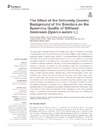Please use this identifier to cite or link to this item:
https://accedacris.ulpgc.es/jspui/handle/10553/107928
| Title: | The Effect of the Deformity Genetic Background of the Breeders on the Spawning Quality of Gilthead Seabream (Sparus aurata L.) | Authors: | Lorenzo Felipe, Alvaro Shin, Hyun Suk León Bernabeu,Sergio Pérez García, Cathaysa Zamorano Serrano, María Jesús Pérez-Sánchez, Jaume Afonso López, Juan Manuel |
UNESCO Clasification: | 310902 Genética 310502 Piscicultura |
Keywords: | Estimated Breeding Value Gilthead Seabream Number Of Alive Larvae Oocyte Yield Skeletal Deformity, et al |
Issue Date: | 2021 | Project: | Mejora de la Competitividad Del Sector de la Dorada A Través de la Selección Genética (Progensa-Iii) PerformFISH |
Journal: | Frontiers In Marine Science | Abstract: | Fish egg quality is strongly related with the ability of the egg to be fertilized and develop a normal embryo with good survival and a lack of abnormalities. Large variations in the spawning quantity or quality impact directly in the competitiveness and sustainability of hatcheries, which create an overly large broodstock in order to satisfy the on-growing companies’ demand for undeformed fry. The present study reports, for the first time in relation to gilthead seabream, the effect of the genetic background of breeders for presence or absence of deformity on their spawning quality and the importance of considering this when creating broodstock. The spawning quality of crosses of breeders with genetic background for presence or absence of deformity (EBVdef), were evaluated during a whole spawning season, through study of the following traits: oocyte yield, fertilization rate, viability rate, hatching rate, larval survival rate, fertilized eggs, viable eggs, hatched eggs, and number of alive larvae. Breeders with a genetic background for deformity and a normal phenotype had shorter spawning periods, lower oocyte yield and, consequently, produced a lower number of alive larvae. In these two traits, the genetic background of breeders was of greater importance during intermediate spawning periods, when spawning is generally considered optimal for the industry, while environmental factors were more important at the beginning and end of the spawning season. In conclusion, these results demonstrate the importance of controlling the breeders’ genetics when creating broodstock. | URI: | https://accedacris.ulpgc.es/handle/10553/107928 | ISSN: | 2296-7745 | DOI: | 10.3389/fmars.2021.656901 | Source: | Frontiers in Marine Science[EISSN 2296-7745],v. 8, (Mayo 2021) |
| Appears in Collections: | Artículos |
SCOPUSTM
Citations
8
checked on Jun 8, 2025
WEB OF SCIENCETM
Citations
9
checked on Jun 8, 2025
Page view(s)
244
checked on Jan 25, 2025
Download(s)
211
checked on Jan 25, 2025
Google ScholarTM
Check
Altmetric
Share
Export metadata
Items in accedaCRIS are protected by copyright, with all rights reserved, unless otherwise indicated.
